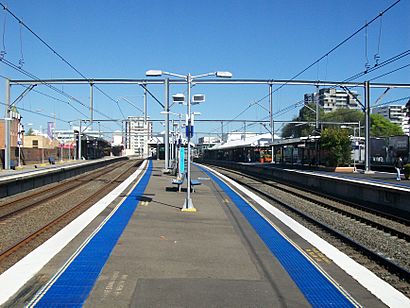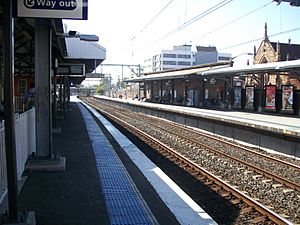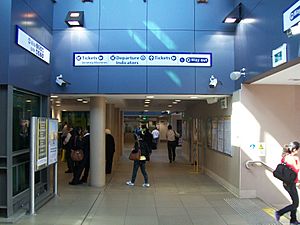Burwood railway station, Sydney facts for kids
Quick facts for kids
Burwood
|
||||||||||||||||
|---|---|---|---|---|---|---|---|---|---|---|---|---|---|---|---|---|

Westbound view from Platform 4 in October 2011
|
||||||||||||||||
| Location | Railway Parade, Burwood | |||||||||||||||
| Coordinates | 33°52′38″S 151°06′16″E / 33.87729°S 151.10432°E | |||||||||||||||
| Owned by | Transport Asset Holding Entity | |||||||||||||||
| Operated by | Sydney Trains | |||||||||||||||
| Line(s) | Main Suburban | |||||||||||||||
| Distance | 10.62 kilometres (6.60 mi) from Central | |||||||||||||||
| Platforms | 6 (2 side, 2 island) | |||||||||||||||
| Tracks | 6 | |||||||||||||||
| Connections | Bus | |||||||||||||||
| Construction | ||||||||||||||||
| Structure type | Elevated | |||||||||||||||
| Disabled access | Yes | |||||||||||||||
| Other information | ||||||||||||||||
| Status | Staffed | |||||||||||||||
| Station code | BWD | |||||||||||||||
| Website | Transport for NSW | |||||||||||||||
| History | ||||||||||||||||
| Opened | 26 September 1855 | |||||||||||||||
| Rebuilt | 13 March 1892 | |||||||||||||||
| Electrified | Yes | |||||||||||||||
| Traffic | ||||||||||||||||
| Passengers (2018) | 40,180 (daily) (Sydney Trains, NSW TrainLink) | |||||||||||||||
| Rank | 13 | |||||||||||||||
| Services | ||||||||||||||||
|
||||||||||||||||
| Official name | Burwood Railway Station group | |||||||||||||||
| Type | State heritage (complex / group) | |||||||||||||||
| Designated | 2 April 1999 | |||||||||||||||
| Reference no. | 1106 | |||||||||||||||
| Type | Railway Platform/ Station | |||||||||||||||
| Category | Transport - Rail | |||||||||||||||
Burwood railway station is a historic train station in the Sydney suburb of Burwood, Australia. It's located on the Main Suburban line. This station is an important part of Sydney's history and is served by Sydney Trains' T9 Northern line and T2 Inner West & Leppington line services.
Contents
History of Burwood
Early Days and Land Grants
In 1791, Parramatta Road was built, connecting Sydney Cove to the farming areas. Later, Liverpool Road opened in 1814. These roads were vital for moving goods and people. The area around Burwood was mostly thick forest.
Large pieces of land, called grants, were given out. One important grant was Captain Thomas Rowley's Burwood Farm estate. He named it after his farm in England. Another big grant was William Faithful's land to the south in Enfield. These large farms slowly started to be divided into smaller plots.
Growth of the Area
For many years, Burwood had only a few inns along the main roads and some very large, undeveloped estates. But by the 1830s, these big estates began to break up. This attracted more settlers and helped small villages like Burwood and Enfield grow.
The biggest change came with the railway. In 1855, the first railway line to Parramatta opened. Burwood got a simple wooden platform near a level crossing. This new, fast way to travel encouraged more people to move to the area. Burwood's population grew a lot between 1874 and 1900.
Burwood Railway Station: A Timeline
Station Development
The first Burwood station opened on 26 September 1855. It was at ground level, west of Burwood Road. In 1892, the station was moved to its current spot on the east side of Burwood Road. This happened when the railway line was made wider, adding more tracks. Later, in 1922, even more tracks were added, making it a six-track line.
Post Office and Goods Yard
In 1869, a post office was set up at the railway station. A new building for the post office was built at the station in 1886. This building is still there today. It was originally built by the Railway Department as a Post & Telegraph Office. It's a rare example of a post office built specifically for a railway station.
The station also had a goods yard, which was a place for trains to load and unload goods. You can still see some parts of this old goods yard, like a crane and a weighbridge. These items remind us of how important the railway was for moving goods in the past. Many other goods yards like this have disappeared.
Modern Upgrades
In 2009-2010, Burwood station got a big upgrade. This was done to help with the large number of passengers using the station. The work included making the main hall (concourse) bigger and adding more ticket barriers. New toilets and lifts were also installed to make it easier for everyone to access the platforms. The upgrade was finished in mid-2010.
Platforms and Services
Burwood station has six platforms. Trains from here can take you to many places across Sydney.
| Platform | Line | Stopping pattern | Notes |
| 1 | T9 | Peak hour services to Central (i, Platforms 1-12) | |
|---|---|---|---|
| 2 | T9 | Peak hour services to services to Hornsby via Strathfield | |
| 3 | T9 | services to Central & Gordon | |
| 4 | T9 | services to Hornsby via Strathfield | |
| 5 |
2
|
services to Central & the City Circle | |
| 6 |
2
|
services to Homebush, Parramatta & Leppington |
Station Buildings and Features
The station has a brick building for buying tickets, which was completed in 1892. There's also a brick parcels office, which used to be a railway post office.
Other features include a subway for people to walk under the tracks, steps, a 5-tonne (6-short-ton; 5-long-ton) crane, and a weighbridge. These parts show how the station has changed over time.
Getting Around: Transport Links
Burwood station is a major transport hub, meaning many buses also stop here.
Transdev NSW operates one route from Burwood station:
- M90: to Liverpool station via Bankstown station
Transit Systems operate 16 routes via Burwood station:
- 407: to Strathfield station via Homebush West
- 408: to Rookwood
- 410: Hurstville to Marsfield via Campsie
- 415: Campsie to Chiswick
- 418: to Kingsford via Sydenham
- 420: Westfield Burwood to Westfield Eastgardens via Sydney Airport.
- 420N: Westfield Burwood to Westfield Eastgardens Night service.
- 458: to Ryde
- 461X: to The Domain
- 461N: to City - Hyde Park Night service
- 464: Ashfield station to Mortlake
- 466: to Cabarita Park
- 490: Drummoyne to Hurstville
- 492: Drummoyne to Rockdale
- 526: to Olympic Park wharf and Rhodes
- 530: to Chatswood station via Drummoyne & Lane Cove
Burwood station is also served by three NightRide bus routes, which run late at night:
- N50: Liverpool station to City (Town Hall)
- N60: Fairfield station to City (Town Hall)
- N61: Carlingford station to City (Town Hall)
Heritage Importance
Burwood railway station is listed on the New South Wales State Heritage Register. This means it's considered a very important historical site. The station's old buildings, like the former railway post office, are rare examples of their kind. They help us understand how railway stations and services developed in New South Wales. The station shows how the railway line was upgraded over time, especially in 1892.



